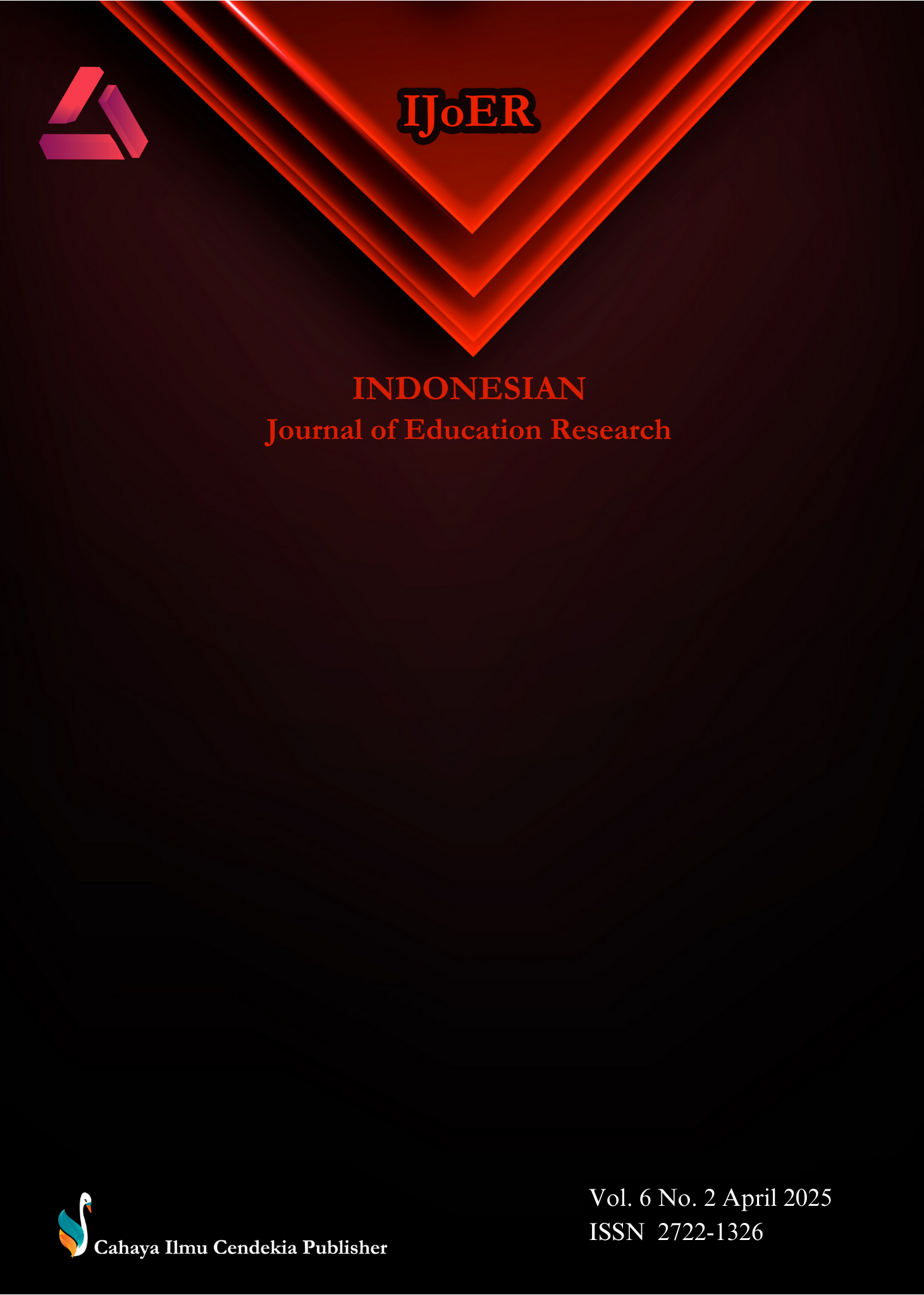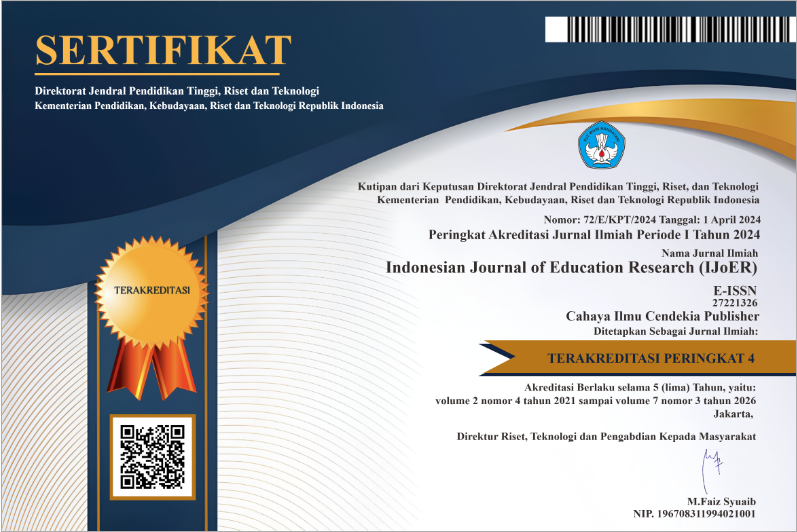Teachers’ Insights on Instructional Leaders: Understanding the Impact of Directors’ Practices on Motivation
Abstract
Purpose of the study: This study consists of two main research objectives. The first objective is to assess the insights of teachers toward their school directors’ ILP and how these practices affect TEM. The second objective is to compare the insights of teachers toward their school directors’ ILP based on teachers’ demographic information.
Methodology: The researcher uses quantitative reseach with a survey approach using descriptive statistics, independent sample t-test, and one-way ANOVA to address the research objectives. 295 state junior high school teachers who were pursuing higher education at a private university participated in this survey.
Main Findings: The results indicated that teachers have high insights toward their school directors’ ILP (M = 3.94), and school directors’ ILP has a high influence on TEM (M = 4.22). Furthermore, the researcher discovered that gender and age did have significant effects on TEI toward school directors’ ILP, and levels of current study also significantly influences TEM (p < 0.05). In contrast, gender and TEM, age and TEM, levels of current study and ILP, teaching experience and ILP and TEM, do not have any significant effects (p < 0.05).
Novelty/Originality of this study: These findings may provide significant keys to fostering TEM through effective ILP. In addition, these leadership practices enhance TEM within the Cambodian state junior high school context. Hence, school directors, academic staff and teachers can apply these findings in their duties in enhacing institutional’s success. Future research should incorporate diverse educational contexts and additional moderating variables to provide a more comprehensive understanding of the relationship between leadership behavior and TEM in other areas.
References
S. Tep, “An examination of extrinsic motivation effects on students in learning English in higher education.,” Proj. Prof. J. Engl. Educ., vol. 5, no. 6, pp. 1270–1278, 2022, doi: 10.22460/project.v5i6.p1270-1278.
K. Sandhya and D. P. Kumar, “Employee retention by motivation.,” Indian J. Sci. Technol., vol. 4, no. 12, pp. 1778–1782, 2011, https://sciresol.s3.us-east-2.amazonaws.com/IJST/Articles/2011/Issue-12/Article33.pdf
K. Al Tayyar, “Job satisfaction and motivation amongst secondary school teachers in Saudi Arabia,” Dissertation, University of York, 2014.
F. Guay, J. Chanal, C. F. Ratelle, H. W. Marsh, S. Larose, and M. Boivin, “Intrinsic, identified, and controlled types of motivation for school subjects in young elementary school children.,” Br. J. Educ. Psychol., vol. 80, no. 4, pp. 711–735, 2010, doi: 10.1348/000709910X499084.
M. R. Tartani, “The impact of employees’ motivation on their performance in Hospitality industry.,” International Hellenic University, 2023.
P. Riley, “Attachment theory, Teacher Motivation & pastoral care: A challenge for teachers and academics.,” Pastor. Care Educ., vol. 31, no. 2, pp. 112–129, 2013, doi: 10.1080/02643944.2013.774043.
G. Engin, “An Examination of Primary School Students’ Academic Achievements and Motivation in Terms of Parents’ Attitudes, Teacher Motivation, Teacher Self-Efficacy and Leadership Approach.,” Int. J. Progress. Educ., vol. 16, no. 1, pp. 257–276, 2016, https://eric.ed.gov/?id=EJ1244883.
D. Christian and Y. Sayed, “Teacher motivation to teach in challenging school contexts on the Cape Flats, Western Cape, South Africa.,” Educ. Sci., vol. 13, no. 2, p. 165, 20223, doi: 10.3390/educsci13020165.
D. Kerdtip and S. A. Sa-au, “Leadership in Action: Unveiling Positive Leadership Traits of Southern Thailand Public-School Administrators.,” Pak. J. Life Soc. Sci., vol. 22, no. 2, pp. 2851–2865, 2024, doi: 10.57239/PJLSS-2024-22.2.00209.
J. A. Wahab, A. Z. Mansor, M. Hussin, and S. Kumarasamy, “Headmasters’ Instructional Leadership and Its Relationship with Teachers Performance.,” Univers. J. Educ. Res., vol. 8, no. 11A, pp. 97–102, 2020, doi: doi: 10.13189/ujer.2020.082112.
P. Hallinger, S. Liu, and P. Piyaman, “Does principal leadership make a difference in teacher professional learning? A comparative study China and Thailand. Compare.,” J. Comp. Int. Educ., vol. 49, no. 3, pp. 341–357, 2019.
S. Liu and P. Hallinger, “Principal instructional leadership, teacher self-efficacy, and teacher professional learning in China: testing a mediated-effects model.,” Educ. Adm. Q., vol. 54, no. 4, pp. 501–528, doi: 10.1177/0013161X18769048.
S. Pongoh, “The Effect of Principal Leadership and Achievement Motivation on Teaching Competence of Public School Teacher in Manado City.,” J. Educ. Pract., vol. 5, no. 1, 2014.
X. Ran, R. B. Rosli, and D. A. Ali, “The Impact of Transactional Leadership on Work Performance: The Mediating Role of Work Engagement.,” Int. J. Recent Trends Bus. Tour. IJRTBT, vol. 8, no. 3, pp. 38–46, 2024.
K. M. Williams, “Dynamics of Efficacy for Teachers in Formal Leadership Roles: A Case Study.,” East Tennessee State University, 2015.
M. B. Beyer and C. Ruhl-Smith, “The principal’s role in school restructuring and reform: An examination of self-perceived leadership styles.,” J. Leadersh. Stud., vol. 5, no. 2, pp. 116–128, 1998, doi: 10.1177/107179199900500210.
N. P. Ololube, “Teachers job satisfaction and motivation for school effectiveness: An assessment.,” Essays Educ., vol. 18, no. 1, p. 9, 2006, doi: doi:10.6007/IJARPED/v12-i4/20089.
B. Han, R. Tösten, and Z. Elçiçek, “Public leadership behaviors of school principals: does it affect Teacher Motivation and job satisfaction in Turkish culture?.,” Int. J. Public Leadersh., vol. 18, no. 3, pp. 209–228, 2022.
A. G. Kruger, “Instructional leadership: the impact on the culture of teaching and learning in two effective secondary schools,” South Afr. J. Educ., vol. 23, no. 3, pp. 206–211, 2003, https://www.ajol.info/index.php/saje/article/view/24935
D. C. Wilson, “Defining Leadership.,” Philos. Manag., vol. 22, no. 1, pp. 99–128, 2023, https://link.springer.com/article/10.1007/s40926-022-00210-7
C. Day, P. Sammons, and K. Gorgen, Successful School Leadership. Education development trust., 2020.
F. Kayalar, “The roles of the school principals on promoting resilience in novice teachers at secondary schools.,” Int. J. Soc. Humanit. Sci. Res., vol. 5, no. 29, pp. 3469–3476, 2018, doi: 10.26450/jshsr.710.
S. Sharma, “Leadership for Learning beyond Instructional-Lessons from Indian Private School Principals.,” Int. Multidiscip. Res. J., vol. 4, no. 1, pp. 50–61, 2016.
D. Wieczorek and C. Manard, “Instructional Leadership Challenges and Practices of Novice Principals in Rural Schools.,” J. Res. Rural Educ., vol. 34, no. 2, 2018, https://jrre.psu.edu/sites/default/files/2019-06/34-2_0.pdf
S. Tep, L. Ratana, and P. Visalboth, “How Principals’ Instructional Leadership Influence Teachers’ Self-Efficacy.,” J. Basic Educ. Res., vol. 6, no. 1, pp. 47–56, 2025, doi: 10.37251/jber.v6i1.1421.
H. M. A. Al Hosani, “Principals’ instructional leadership practices and their relationship to teachers’ instructional practices in sharjah schools.,” Thesis, United Arab Emirates University, 2015.
S. Demirdag, “School Principals’ Instructional Leadership as a Predictor of Teacher Motivation.,” IE Inq. Educ., vol. 13, no. 2, p. 6, 2021, https://digitalcommons.nl.edu/ie/vol13/iss2/6
C. S. Ath, “Impact of School Principals’ Leadership on Teaching Quality and Students’ Achievement: A Case Study of Primary Schools in Phnom Penh, Cambodia,” Doctoral Dissertation, Nagoya University, 2022.
F. Ishaq, M. Hamzeh, and A. A. Tabieh, “The degree of charismatic leadership practice among school principals from teachers perspective.,” Educ. Adm. Theory Pract., vol. 29, no. 1, pp. 58–75, 2023, doi: 10.17762/kuey.v29i1.454.
G. A. Sparks, “Charismatic leadership: Findings of an exploratory investigation of the techniques of influence.,” J. Behav. Stud. Bus., 2014.
R. J. House, “A 1976 Theory of charismatic leadership.,” Work. Pap. Ser. 76-06, 1976, https://eric.ed.gov/?id=ED133827
L. S. Rubio, “Charismatic leadership of school heads, supervisory relationship and reciprocity beliefs: path model on work ethics of public elementary school teachers.,” Eur. J. Educ. Stud., vol. 10, no. 1, pp. 256–342, 2023, https://oapub.org/edu/index.php/ejes/article/view/4654.
B. Shamir and J. M. Howell, “Organizational and contextual influences on the emergence and effectiveness of charismatic leadership.,” Emerald Publ. Ltd., vol. 9, pp. 255–281, 2018, doi: 10.1108/S1479-357120180000009020.
L. G. Martinez, “Charismatic leadership insightss from k-12 administrators: phenomena of follower and leader interdependency.,” 2017.
W. M. W. Mahmud and M. Abdullah, “Relationship of charismatic leadership of principals with motivation of teachers in elite national secondary schools in terengganu.,” Open Access J., vol. 12, no. 4, pp. 891–906, 2023, doi: 10.6007/IJARPED/v12-i4/20089.
E. L. Deci and R. M. Ryan, “Self-Determination Theory.,” in Handbook of theories of social psychology, vol. 1, 2012, pp. 416–436.
E. L. Deci and R. M. Ryan, “Optimizing students’ motivation in the era of testing and pressure: A self-determination theory perspective.,” Singapore: Springer Singapore, 2016, pp. 9–29.
R. M. Ryan and E. L. Deci, Self-Determination Theory: Basic psychological needs in motivation, development, and wellness. Guilford Publications, 2017.
R. M. Ryan and E. L. Deci, “Intrinsic and Extrinsic Motivation from a Self-Determination Theory perspective: Definitions, theory, practices, and future directions.,” Contemp. Educ. Psychol., vol. 61, 2020, doi: 10.1016/j.cedpsych.2020.101860.
M. M. Ünver, “An exploration of perceived self-determination and self-efficacy of EFL instructors in a Turkish state university,” Bilkent Universitesi (Turkey), 2004.
A. W. Knight, “A Self-Determination theory-based analysis of the effects of clinical instructor behavior on student clinical engagement.,” The University of Iowa., 2016.
W. S. Davis and F. Bowles, “Empowerment and intrinsic motivation: A self-determination theory approach to language teaching.,” CSCTFL Rep., vol. 15, 2018.
A. s. Ahmar, “The Influence of Principal Instructional Leadership, School Climate, and Work Motivation on Teacher Professionalism in Public High Schools throughout Barito Kuala Regency.,” EduLine J. Educ. Learn. Innov., vol. 4, no. 1, pp. 53–67, 2024, doi: 10.35877/454RI.eduline2377.
K. Yilmaz, “Comparison of quantitative and qualitative research traditions: Epistemological, theoretical, and methodological differences.,” Eur. J. Educ., vol. 48, no. 2, pp. 311–325, 2013, doi: 10.1111/ejed.12014.
J. W. Creswell and J. D. Creswell, Research design: Qualitative, quantitative, and mixed methods approaches. Sage publications, 2017.
R. V. Krejcie and D. W. Morgan, “Determining sample size for research activities.,” Educ. Psychol. Meas., vol. 30, 1970.
G. Johanson and G. Brooks, “Initial Scale Development: Sample Size for Pilot Studies.,” Educ. Psychol. Meas., vol. 70, pp. 394–400, 2010, doi: 10.1177/0013164409355692.
I. Kennedy, “Sample size determination in test-retest and Cronbach alpha reliability estimates.,” Br. J. Contemp. Educ., vol. 2, no. 1, 2022, doi: 10.52589/BJCE-FY266HK9.
S. Tep, “The correlation between instructional leadership and efficacy among the Cambodian public lower secondary school teachers.,” J. -Salam, vol. 6, no. 2, pp. 163–180, 2022, doi: 10.37249/assalam.v6i2.437.
R. J. Marzano, T. Waters, and B. A. McNulty, School leadership that works: From research to results. ASCD, 2005.
P. Hallinger and R. H. Heck, “Leadership and student learning outcomes.,” in Leadership and learning, Sage publications, 2011, pp. 56–70.
J. C. Maxwell, Real leadership: The 101 collection. HarperCollins, 2006.
Copyright (c) 2025 Sopheng Tep

This work is licensed under a Creative Commons Attribution 4.0 International License.
Authors who publish with this journal agree to the following terms:
- Authors retain copyright and acknowledge that the Indonesian Journal of Education Research (IJoER) is the first publisher licensed under a Creative Commons Attribution 4.0 International License.
- Authors are able to enter into separate, additional contractual arrangements for the non-exclusive distribution of the journal's published version of the work (e.g., post it to an institutional repository or publish it in a book), with an acknowledgment of its initial publication in this journal.
- Authors are permitted and encouraged to post their work online (e.g., in institutional repositories or on their website) prior to and during the submission process, as it can lead to productive exchanges and earlier and greater citation of published work.







.png)
.png)




















